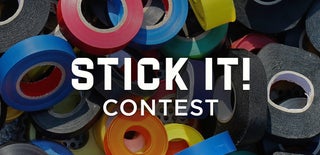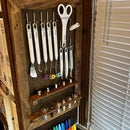Introduction: Oversized (Mascot) Costume
Intro:
Ever since Talking Heads came out with Stop Making Sense (I fully embrace this, more as an a way of life than an attitude) and David Byrne wore that big white oversized suit dancing around, I said “I need to make one of those!”. So a presentation I had to do made for a perfect opportunity to accomplish this, and since this is a Scouting presentation Mr. Big Scout was born!!
Materials used in this project:
- Foam Pool Noodles
- Duct tape
- Double face Duct tape
- Stitch Witchery
- Light Weight Sewing Velcro
- Heavy Duty Industrial Velcro
- Clear Packing Tape
- Scissors
- Iron
- Safety Pins
- Brass Foil
- Beige/Tan Felt
- Black Sharpie
- Beige Fabric
- Tan Fabric
- Green Fabric
- Card Stock
- 1/2” Foam padding
- Craft Foam
Campaign Hat:
- Paper Packing Tape
- Shelving Contact Paper
- Cardboard
- Silver Duct Tape
- Spray Paint
- And an old hard hat head bracket
Step 1: Creating Frame
The best thing I could find that was light weight and flexible are pool noodles. I got two medium size ones. Since they have holes through them it was a simple process of just bending each noodle around (they formed a pretty natural oval shape) and connecting the ends using a small dowel rod (about 6”), wedging each end over the rod. Then securing with clear packing tape. I made two of these, one for the waist, the other for the shoulder harness. To finish the shoulder harness, I cut one of the spare noodles in half. Then bent them into an arch taping each end to the oval with clear packing tape. Also added another cross section between the two arches for back of the neck support. And then two more pieces over each shoulder from cross supports to base of shoulder frames. For additional support I added suspenders to the back frame to drape over shoulders and attach to the front waist via velcro.
Step 2: Measure and Cut Material for Shirt
First off I’m not a seamstress by any means. I know how to sew but nothing like shirts, pants, etc. So Stitch Witchery was my go to for this project. Its awesome for joining fabric together. If you’ve never used this stuff my best advice is to make sure to crease your material and steam iron your areas your going to join. Then insert the strip of stitch witchery an using a dampened handkerchief or small piece of fabric steam iron your pieces together. With the upper shoulder frame created I then measured out my beige shirt material to wrap around and drape over the frame. Since I’ve never attempted to make a shirt before I looked for a what a typical shirt pattern looks like. Using one I found online I made my cuts and then started joining the edges. I recommend using stitch witchery the full length of your seams. I added a fake fold down the front with spare material to simulate the buttoning part of the shirt.
Step 3: Add Shirt Extras
To make the shirt look more like a scout shirt, I cut out extra fabric and shaped them into pockets. Then stitch witched them in place. I tried to give these as much detail to make it look more realistic. Added flaps too. I cut and put small squares of foam padding into the pockets to make them puff out a bit.
Step 4: Attach Shirt
I draped the finished shirt over the upper frame. Then I did a test wear to figure out position the waist frame. I added velcro on the outside of the frame and then pressing to inside of the shirt to join the shirt to the waist frame. At the neck area I used small strips of clear packing tape to join the material to the frame.
Step 5: Measure and Cut Material for Pants
Measure the green material to size around the width of the frame. It was tempting to just make it skirt like but really needed legs to look right. So I split in front and back and stitched back together adding a small piece of material in the front and the back too run between the legs. I put a small strip of velcro to join them in the middle. This help give the pants the true pants/shorts look. As you can see in the pics I had already added the pockets and belt loops and made a paper belt.
Step 6: Add Pockets and Belt Loops
Cut material for front pockets and back pockets. I curved the material on the front pockets. I added the extra smaller pockets on front of the larger pockets again inserting small squares of foam to make them puff out. The belt loops were simple enough to do. Just folding over material and stitch witching them into staggered positions around the pants. Also to give an authentic look I took pics of the actual buttons on my scout pants snap buttons and printed those out on card stock.
Step 7: Add Buttons and Patches
To complete the shirt I added shoulder straps on the top of the shirt with eppilettes. I made the buttons out of foam core and attached using regular velcro. For the patches I simply took pictures of my shirts patches and printed out to scale on card stock, then attached with small strips of velcro. The great thing about doing this as I get other patches I can swap them out.
Step 8: Make Belt
As I mentioned earlier I initially made my belt out of paper printing out the design from one of my own belts. But I quickly realized it wouldn’t survive very long. So I came up with my own design from previous patch designs I had done. I measured out enough tan felt to go around the width of the pants and cut width to fit inside the belt loops. Then I drew my design on the felt and inserted it through the belt loops around the entire waist.
Step 9: Make Belt Buckle
The buckle I cut out of card board. I cut the axe and log out of craft foam. Using double sided duct tape I put in position. I added more double sided tape to the cardboard and then wrapped the whole buckle in brass foil. To simulate the look of the actual buckle I used a burnisher to make it resemble the mottle effect and smooth edges. I used the industrial velcro to join the buckle to the front of the pants.
Step 10: Join Pants to Shirt and Frame
Add standard velcro around the waist level of the shirt on the outside. Accomplish by positioning on the outside of the shirt where you attached the velcro on the inside to attach the frame. With the velcro positioned pull up the pants and add the opposite strip of velcro on the inside of the pants to join pants to shirt.
Step 11: Make Neckerchief, Woggle, and Beads
I cut a stiffer piece of beige material I had (closer in color to a Wood Badge neckerchief) and fashioned a neckerchief. I rolled a small stretch of rope into the inside edge of it to help hold its shape. I also ran a leather cord with the rope. I added wood dowel rods fashioned into official looking Wood Badge Beads. Using some leftover rope I tied a large turks head knot to form the woggle (neckerchief slide). To attach this whole thing I added velcro to the underside of the neckerchief and the around the shirt neck frame.
Step 12: Custom Made Campaign (Smokey) Hat
Now the original hat I used was donated to me. Its a long story, so I’ll spare you. As you can see it was huge and it was very cumbersome and difficult to wear(a true pain in the neck). When it was given to me it was in pretty bad shape. I cleaned it up as best I could. At the time I had to use it and its the one featured in most of the pictures in costume and videos.
But I decided to redesign and make one more along the line to match my costume. Using cardboard I cut and matched the shape of the foam rings. I had this cardboard tube from work that was rather large, so I cut it down to about 7-8” tall and center on the cardboard. I used paper packing tape to join them together. I cut the tube in to smaller strips and then quartered the ring and positioned them on top of the tube ring to fashion the upper campaign effect of the hat. Using paper packing tape I filled in the concave sections. Once the hat shape was complete I painted the whole hat with brown paint. I made the head band out of faux leather contact paper. I made the medallion out cardboard and wrap the edge in silver duct tape. I printed out a picture of the medallion on card stock and spray glued it to the front. I mounted the medallion to the hat with double sided duct tape. I cut an opening underneath for my head and mounted and spare hard hat helmet bracket. This helps keep the hat in place when wearing it.
Step 13: Post Note
The finished result I was very pleased with as were the participants at my presentation. Its proven to be very popular among the scouts and scouters. Check out the video from my Rockets presentation. And since the majority the costume is fabric, I can and have simply remove all the patches/extras to wash and iron when needed. Then reattach and assemble for the next outing.
Bonus unknown benefit of creating my own hat, that was to the size of the costume, gives the costume a good storage base. I simply fold the pants inward and rest the waist frame on the top side of the hat, and drape shirt down resting the shoulder frame top. Store the whole thing in a large leaf garbage bag.
I hope this inspires you to make your own oversized costume.

Participated in the
Stick It! Contest













